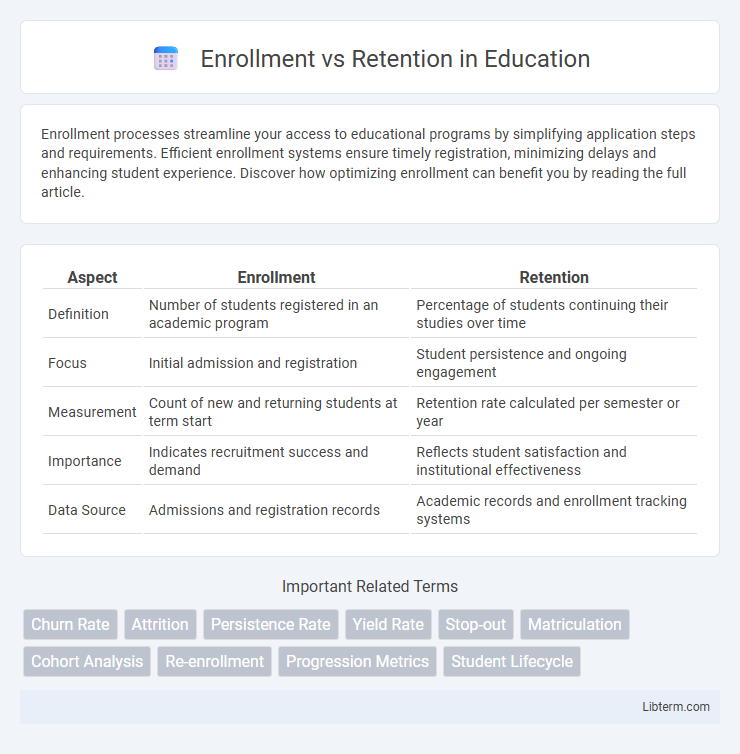Enrollment processes streamline your access to educational programs by simplifying application steps and requirements. Efficient enrollment systems ensure timely registration, minimizing delays and enhancing student experience. Discover how optimizing enrollment can benefit you by reading the full article.
Table of Comparison
| Aspect | Enrollment | Retention |
|---|---|---|
| Definition | Number of students registered in an academic program | Percentage of students continuing their studies over time |
| Focus | Initial admission and registration | Student persistence and ongoing engagement |
| Measurement | Count of new and returning students at term start | Retention rate calculated per semester or year |
| Importance | Indicates recruitment success and demand | Reflects student satisfaction and institutional effectiveness |
| Data Source | Admissions and registration records | Academic records and enrollment tracking systems |
Understanding Enrollment and Retention
Enrollment measures the total number of students registered at an institution during a specific period, reflecting initial interest and outreach effectiveness. Retention tracks the percentage of those students who continue their studies in subsequent terms, indicating student satisfaction and institutional support quality. Understanding enrollment and retention dynamics helps educational institutions optimize recruitment strategies and improve student success outcomes.
Key Differences Between Enrollment and Retention
Enrollment refers to the initial process of registering or signing up students in an educational institution, while retention measures the ability of that institution to keep students enrolled through graduation or program completion. Key differences include enrollment focusing on the quantity of new students admitted each term, whereas retention emphasizes student engagement, satisfaction, and support systems to reduce dropout rates. Metrics such as enrollment rates track new student intake, while retention rates assess ongoing student persistence and institutional effectiveness.
The Importance of Enrollment in Educational Institutions
Enrollment in educational institutions represents the initial step in engaging students and directly influences the institution's funding, reputation, and overall growth. High enrollment rates not only reflect the demand and credibility of academic programs but also enable schools to allocate resources effectively for better learning environments. Securing robust enrollment ensures a diverse and dynamic student body, which is critical for fostering innovation and maintaining competitive standing in the educational sector.
Factors Influencing Student Enrollment
Student enrollment is primarily influenced by factors such as academic program offerings, tuition costs, campus facilities, and institutional reputation, which shape prospective students' decisions. Geographic location and availability of financial aid also play critical roles in attracting diverse student populations. Understanding these elements enables institutions to tailor recruitment strategies to enhance enrollment rates effectively.
The Role of Retention in Academic Success
Retention plays a critical role in academic success by ensuring that students remain engaged and motivated throughout their educational journey. High retention rates correlate strongly with improved graduation rates and long-term career achievement, reflecting institutions' effectiveness in providing supportive learning environments. Academic support services, personalized advising, and community-building initiatives are key factors influencing retention and subsequent student success.
Strategies to Improve Student Retention
Effective student retention strategies prioritize personalized academic support, early alert systems, and engaging extracurricular activities to foster a sense of belonging. Utilizing data analytics enables institutions to identify at-risk students and tailor interventions, increasing overall retention rates. Comprehensive orientation programs combined with continuous mentorship significantly enhance student commitment and academic success.
Common Challenges in Enrollment and Retention
Common challenges in enrollment include inaccurate targeting, complex application processes, and limited outreach, which hinder attracting prospective students. Retention struggles often stem from insufficient student support, lack of engagement, and academic difficulty, leading to higher dropout rates. Addressing these obstacles requires strategic communication, personalized assistance, and robust academic resources to improve both enrollment and retention outcomes.
Measuring Enrollment and Retention Rates
Measuring enrollment rates involves tracking the number of new students registering within a specific period, often expressed as a percentage of the target population. Retention rates measure the percentage of students who continue their studies from one academic term or year to the next, reflecting the institution's ability to maintain student engagement. Accurate data collection on both enrollment and retention rates is essential for assessing institutional performance, guiding resource allocation, and improving student success strategies.
Impact of Enrollment and Retention on Institutional Growth
Enrollment drives immediate institutional growth by increasing student numbers, which boosts revenue and expands campus diversity. Retention enhances long-term stability and reputation by maintaining consistent student populations, reducing dropout rates, and improving graduation outcomes. Together, high enrollment and strong retention synergize to maximize financial sustainability, academic quality, and alumni engagement.
Future Trends in Enrollment and Retention
Future trends in enrollment and retention highlight the increasing role of artificial intelligence and data analytics to personalize student experiences and improve engagement. Institutions are leveraging predictive modeling to identify at-risk students early, enabling targeted interventions that boost retention rates. Flexible learning options, including online and hybrid programs, continue to attract diverse student populations, reshaping traditional enrollment patterns.
Enrollment Infographic

 libterm.com
libterm.com